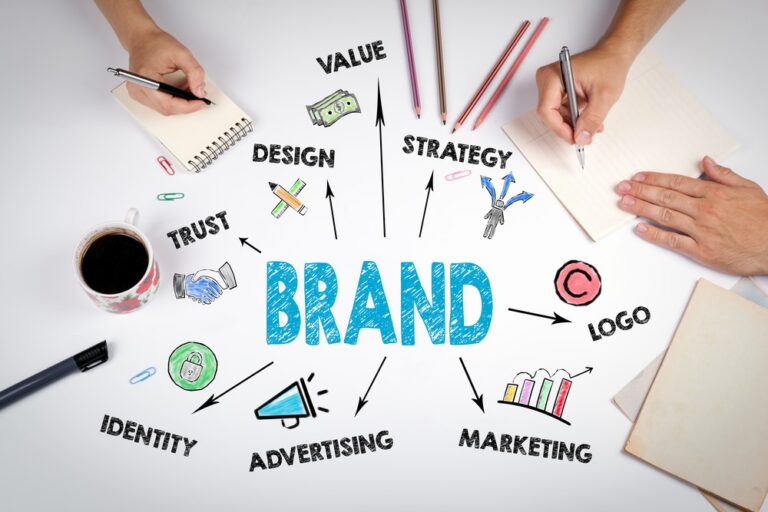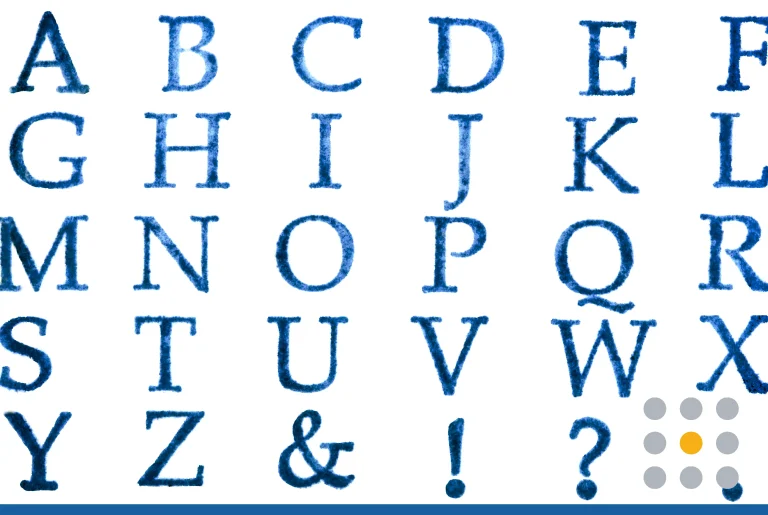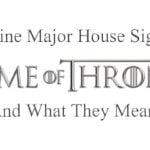From clothing to appliances and all the delicious food in between, you come across countless logos every single day. Some of these logos have risen above the rest to become truly iconic. These famous logos don’t just represent their brands, but they have a knack for grabbing our attention and sticking in our minds for a long time.
In this article, we’ll explore what makes a logo design iconic, how to create a great logo, and the stories behind some of the most famous logos in history.
- What Makes a Logo Iconic?
- Creating an Iconic Logo
- Famous Logos & Their Stories
- Iconic Technology Logos
- Famous Logos From the Fashion World
- Quintessential Food & Beverage Logos
- Instantly Recognizable Sports Logos
- Legendary Automotive Logos
- Convenience Brands with Amazing Logos
- Great Logos From the Entertainment Industry
- Captivating Logos for Environmental & Relief Organizations
What Makes a Logo Iconic?
An iconic logo is instantly recognizable and perfectly encapsulates the essence of the brand that it represents.
But here’s the thing: for a logo to truly become iconic, the brand behind it needs to have some iconic qualities, too. Even the most beautifully designed logo won’t stand out if people aren’t seeing it. So, without that visibility, it can’t evolve into that memorable symbol we all know and love.
On average, a person needs to see your professional logo 5 to 7 times before they’ll remember your brand. This number becomes infinitely larger when you’re trying to make your logo something that people will remember forever.
There are a few often observed traits that most famous logos have in common:
- Simplicity
- Memorability
- Timelessness
- A bold and dynamic color scheme
- A clear and concise message

Brand Identity
A logo is a central part of a company’s brand identity, and it plays a significant role in shaping the company’s values and mission. A thoughtfully crafted logo can bring a company’s brand identity to life and make it more recognizable and memorable.
Creating an Iconic Logo
There is no secret formula to creating an iconic logo (unfortunately). There are millions of well-designed logos that don’t reach icon status. But if you create a catchy image that really shows off the heart and soul of your company and you invest in getting that image out to your customers, your logo could have a fantastic shot at becoming truly iconic.
Creating an amazing logo that can stand the test of time is like a fun adventure, and a huge part of it is getting to know the target audience you’re designing for. If you’re creating a logo for a sportswear company, you want the logo to represent speed, agility, and athleticism. However, if you’re creating a logo for a real estate business, you would want your logo to represent knowledge, ooze comfort, and professionalism.
FreeLogoServices offers a full suite of logo design tools to help you create an amazing logo in minutes!
Famous Logos & Their Stories
We’ll go through some of the most famous logos in history and explain what makes them so memorable and what elements you can incorporate into your own logo design.
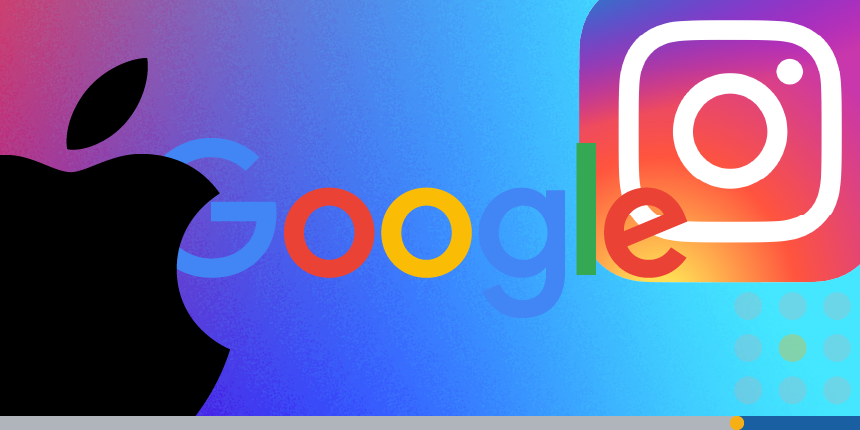
Iconic Technology Logos
As we plunge headfirst into the digital world, technology companies are popping up like toasters in a kitchen! These logos shout innovation, reliability, and a hint of adventurous spirit, making us believe that maybe they really do know what they’re doing.
1. Apple
The Apple logo is instantly recognizable and has become synonymous with innovation. The distinctive logo features a stylized image of an apple with a bite taken out of it. The logo was designed by Rob Janoff in 1977 and has undergone several significant changes over the years.
Interestingly, Apple’s first logo was quite different. It was designed by Ron Wayne and featured Isaac Newton under an apple tree. It was a great illustration, but it was mostly that rather than a logo. So the company quickly transitioned to the Apple logo we all recognize today.
There has always been some debate over where the name Apple came from. Some claim that it was a nod to Apple Records, the company started by the Beatles. According to Apple’s co-founder Steve Jobs, the company’s name was partially inspired by his visit to an apple farm while on a fruitarian diet.
Jobs expanded the explanation in a 1980 interview, where he explained that he gave Apple the name partly because he liked apples and partially because Apple is ahead of Atari (Jobs’ previous employer) in the phone book.
2. Google
You would be hard-pressed to find someone in the world who doesn’t use Google on a daily basis. The Google logo is like a happy, colorful sticker with the company’s name styled in a playful font, which is meant to represent the company’s fun and innovative approach to technology.
The Google logo was designed by company co-founder Larry Page in 1997 and has undergone several changes over the years, but its core design has remained the same. The logo’s primary colors (red, yellow, and blue) are interrupted by a single green “L,” showcasing Google’s spirit of breaking the rules and being unconventional.
Google dominates the search engine space with a staggering 90% market share worldwide. Because Google have become so well-known they have decided to do something very unique with their logo. They are famous for altering the logo design according to important days or historical events.
3. IBM
Even though IBM is a digital brand, IBM’s first logo was created by hand. The original logo was designed by Paul Rand. While Rand’s original logo has been updated through the years, it has always retained a sense of professionalism, power, and precision.
The logo went through a redesign in the mid 1960s, also headed by Paul Rand. Rand created the now iconic IBM logo by placing each letter side by side and adding equal stripes that perfectly went through each letter.
This logo update appealed to IBM’s audience and lasted for more than 50 years. The stripes symbolize speed and dynamism, aligning with IBM’s vision of being a leader in technology. The color blue signifies professionalism, trust, and stability. Blue is a very common color for many famous technology company logos.
4. Instagram
Instagram has over 2 billion active monthly users, making it one of the most popular social media apps in the world. The company has had two distinct logo designs in its nearly 15-year history. The original logo was designed in 2010 and drew inspiration from old Polaroid cameras, providing it with a vintage feel.
During the 2010s, Instagram became much more popular, gaining millions of new users. At the same time, there was a trend of minimalist logos spearheaded by companies like Apple. In 2016, Instagram unveiled a new logo, which had a simple camera graphic with a bold and vibrant pink, yellow, and purple gradient.
The Instagram logo redesign was well-received, and the bright new colors represented the brand’s evolution from a simple photo-sharing app into a global, multifaceted social space.
5. Dell
For the last 35 years, Dell’s signature wordmark logo has remained consistent, only changing a handful of time times.
The version of the Dell logo that we are most familiar with was developed in 1989. This was the first time Dell moved away from a black typeface and relied solely on their iconic shade of blue. The logo was straightforward, with a unique twist: the tilted “E.” This slant represents a floppy disk, paying homage to the company’s early involvement in computer hardware. It’s a subtle nod to Dell’s innovative spirit and roots in tech.
Throughout the years, Dell used a handful of design agencies and branding firms from New York City to make edits to their company’s logo. Dell felt that professionals could make the brand stand out more than the company could if they tackled the design brief themselves.
In the past, even massive companies like Dell needed to go to a professional graphic designer for their corporate logo designs. Today, resources like FreeLogoServices offer comprehensive logo design options that negate the need for a professional graphic designer and can help you create a memorable logo to expand your business.
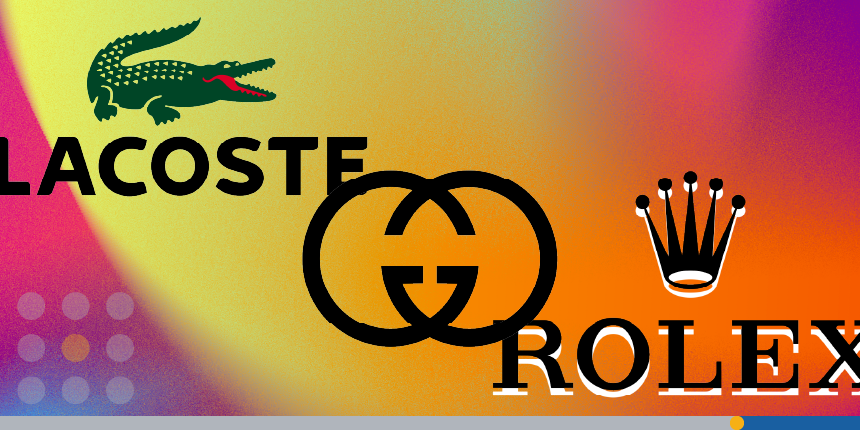
Famous Logos From the Fashion World
Fashion logos have become status symbols in the modern world. When you wear a particular brand, it says a little something about who you are. Many fashion logos share common features that radiate elegance, luxury, and that classic vibe we all love. You’ll often find a minimalist approach with simple yet striking designs, focusing on clean lines and charming little details that catch the eye!
1. Gucci
Established in Florence, Italy, in 1921, the Gucci brand comes from a high-end Italian fashion house. The Gucci logo was designed by Aldo Gucci and consists of two G letters facing each other, which characterize the name of the company’s founder, Guccio Gucci (Aldo’s father). These letters stand for veracity, grandeur, authority, and sophistication.
Over the years, the interlocking design became such a popular emblem that the company used this logo on its clothing, handbags, footwear, and accessories. The double G logo design quickly became a status symbol, so much so that the bootleg fashion market was inundated with fake Gucci’s.
In 2019, the company debuted a new version of the interlocking G design. The company came up with an overlapping Gs design with right-oriented letters. The softer and more subtle logo design still represents the elegance and class that made the original Gucci logo iconic.
2. Rolex
Speaking of status symbols, there is perhaps no bigger status symbol brand in the world than Rolex. By invoking the crown imagery, Rolex has crowned themselves as the best watchmakers ever.
Rolex was founded by 24-year-old Hans Wilsdorf in 1905. Rolex’s crown logo perfectly integrates its slogan, “A Crown for Every Achievement.” The crown symbolizes prestige and excellence, aligning with the company’s focus on luxury timepieces. The gold color reinforces its image of wealth and royalty.
Rolex has managed to create a brand identity linked to exclusivity by intentionally limiting the availability of its timepieces in retail stores. If everyone had a Rolex, they would no longer be special. Having the golden crown on your wrist indicates that you’re able to afford and gain access to one of the most exclusive brands in the world. Because of this, the Rolex logo has become an aspirational image for many people.
3. GAP
The initial GAP logo arrived in 1969 with the words “THE GAP” as the wordmark logo. The logo changed in 1984 when the famous logo lost the “the” and introduced the blue box. This logo design lasted for over 25 years until the company decided to make a shift in 2010.
Even the most famous brand logos change over time, sometimes to evolve to the most recent trends, sometimes to inject some excitement into a brand on the decline. In 2010, following several years of poor financial returns, GAP decided to give its classic logo a revamp with the hopes that this would revitalize sales. However, this backfired, and GAP quickly switched back to its original logo in under a week.
This instance became a case study of how logos can resonate deeply with brand recognition and consumer loyalty. Passionate consumers create long-lasting logo associations, and when that logo symbol is changed abruptly, it can seem as if the entire company is changing along with it. That’s why it’s so important to get feedback from your core customer base before you make these large-scale marketing decisions.
4. Lacoste
The Lacoste logo is a green crocodile, chosen because of the nickname of its founder, René Lacoste, who was called “The Crocodile” due to his tenacity on the tennis court. The logo has since become synonymous with casual, upscale fashion.
Lacoste was involved in a long-standing dispute over its logo with Hong Kong-based sportswear company Crocodile Garments. At the time, Lacoste used a crocodile logo that faced right, while Crocodile used one that faced left. The two companies eventually settled the dispute in international trademark court. As part of the agreement, Crocodile agreed to change its logo, which now sports scalier skin, bigger eyes and a tail that rises vertically.
There is always a chance that your logo may resemble an existing logo somewhere in the world. Before moving forward with your logo design, you should always do market research to see if a similar logo is already in use. To help avoid this issue, you can use FreeLogoService’s extensive library of over 10,000 logo templates with customization features to ensure your business logo is one-of-a-kind.
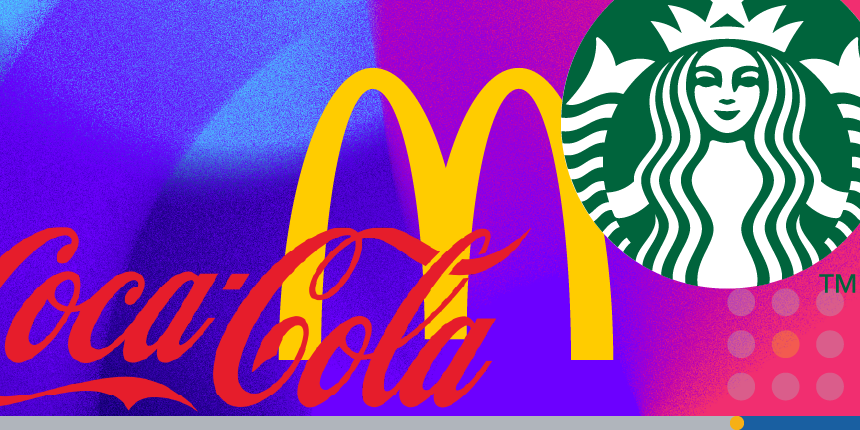
Quintessential Food & Beverage Logos
Food and beverage companies often delight us with some of the most creative logos around! These logos strive to create a sense of comfort and familiarity, making customers feel right at home in their favorite spots. They love to use bright, warm colors like red, yellow, and orange that spark appetite, joy and happiness in everyone who sees them!
1. McDonald’s
Sometimes famous logos are abstract designs, but in the case of McDonald’s, the logo was based on real life. When the first franchised McDonald’s restaurant was put up in 1952, the golden arches were a part of the exterior design of the establishment. The arches were incorporated into the company’s official logo nine years later and have transitioned into a cultural icon known around the world.
The brand colors of yellow and red were carefully chosen. Red represents energy and stimulation, while yellow is associated with happiness. Having the arches in yellow also led to greater visibility, allowing people to spot the McDonald’s logo on an overcrowded road easily.
The McDonald’s logo shows the importance of simplicity in logo design. Your logo does not have to be overly complex to elicit complex emotions in your customers. The striking colors and simple yet elegant design make the McDonald’s logo instantly recognizable whenever you see it.
2. Starbucks
While waiting in line for your coffee, you might have wondered why the Starbucks logo includes a mermaid as an emblem. The first Starbucks restaurant appeared in Portland, around an area surrounded by the ocean. The first iteration of the logo was a nod to this maritime setting, which explains the inclusion of the double-tailed siren (or mermaid).
While the original Starbucks logo was certainly unique, it also had a slightly cluttered look. In 1987, Terry Heckler redesigned the logo to include the words “Starbucks Coffee,” and he simplified the mermaid design.
As the years went on, Starbucks continued to refine the logo, making it more and more minimalistic. Starbucks dropped elements of the logo that surrounded the siren. Starbucks realized that the company logo was was powerful enough to stand on its own and to have only the siren as the central character representing the brand.
3. Pepsi
The Pepsi logo has been evolving for over a hundred years, all to create a unique brand identity. The initial Pepsi-Cola logo was red and had a very similar font to the classic Coca-Cola logo. Pepsi struggled to get out from under the shadow of the competing brand. This brand confusion forced Pepsi to make some drastic changes to help them stand out.
In 1950, the brand introduced the iconic blue color to its bottle caps—and logo—for the first time. In 1975, Pepsi started the Pepsi Challenge to really push its growth by taking a share of Coca-Cola’s audience. The marketing stunt worked incredibly well and even forced Coca-Cola to change its famous recipe, which turned out to be a big mistake, leading to widespread customer dissatisfaction. Coca-Cola would eventually go back to its original recipe, but Pepsi was now seen as a genuine threat to Coke’s soft drink supremacy.
Pepsi would continue to push the envelope by creating a 3d logo design with much more blue in 1998. The logo went through another major shift in 2008 when Pepsi paid the Arnell Group more than $1 million to redesign its logo. The new logo was much more simple in preparation for the rising wave of virtual storefronts and digital brand presence.
4. Coca-Cola
Unlike Pepsi, the Coca-Cola logo has remained constant since the company began in 1886. The famous script logo was created by Frank M. Robinson, the company’s bookkeeper, who believed the two C’s would look appealing in advertising. The design has remained largely unchanged since the late 1800s, representing continuity, tradition, and a unique visual identity.
While many companies use red in their logos because it symbolizes warmth and happiness, Coca-Cola had a much more pragmatic reason for adopting the red color. Red was chosen as the primary brand color because the bottles needed to be painted red to distinguish them from alcohol during transit.
Overall, Coca-Cola’s logo has consistently been successful amidst changes. The company understood what was worth changing and what was important enough to keep— while paying respect to its history and traditions. Logo associations begin when a person sees a logo between 5-10 times; however, in order for those associations to continue to grow, there must be a sense of continuity in a company’s branding. No one has understood the importance of brand continuity more than Coca-Cola.
5. Toblerone
Toblerone’s visual branding is centred around a mountain theme. The logo depicts the Matterhorn Mountain in Zermatt. Being a well-known Swiss symbol, the Toblerone logo pays homage to its motherland.
At first glance, the Toblerone logo looks like a mountain and nothing more. However, a clever optical illusion hidden in the outline of the mountains shows the image of a white bear. This is a playful callback to the brand’s Swiss origins and its hometown, Bern, known as the “City of Bears.”
Many famous logos contain a hidden meaning that rewards keen-eyed consumers.
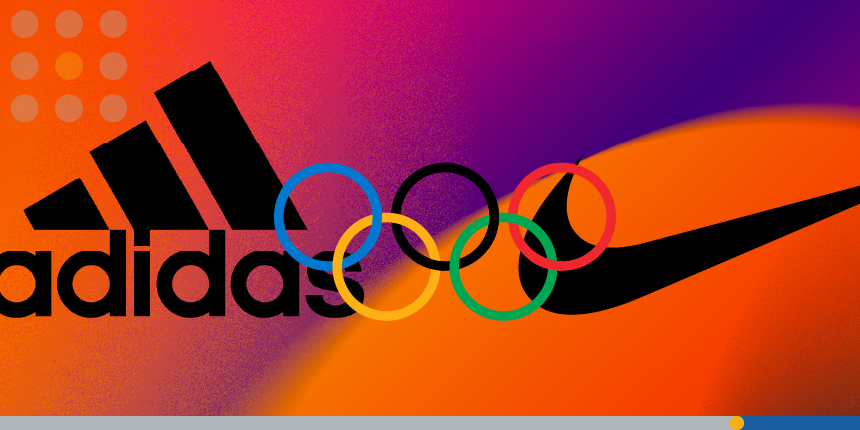
Instantly Recognizable Sports Logos
Sports logos are all about being bold, dynamic, and full of energy! They capture the passion and excitement of athletics in a fun way. You’ll often see vibrant shapes and lively imagery like animals, mascots, or symbols that really bring out the spirit of strength and friendly competition.
1. Nike
When you think about the most iconic logos of all time, the Nike logo is the first thing that will pop into your mind. Considering the massive success that this logo has had, you would be safe in assuming that the Nike branding team spent thousands of dollars to create it but you would be wrong.
In 1971, Nike founder Phil Knight paid graphic designer Carolyn Davidson $35 for the now iconic swoosh logo. The company logo was meant to inspire movement and determination. The swoosh represented the wings of the Greek goddess of victory Nike.
By 1983, Nike had become one of the largest sports companies in the world, and they invited Carolyn Davidson to an executive dinner in her honor. Nike awarded Davidson with a diamond ring in the shape of a swoosh and company shares that are estimated to be worth over a million dollars today.
The story behind the Nike logo shows that you do not need to spend a lot of money to create an amazing logo symbol. If you want to create your own company logo without breaking the bank, you can use FreeLogoService’s affordable logo-making tools and resources.
2. Olympics
The 2024 Paris Olympics had an average viewership of 30.4 million viewers. The Olympics is one of the world’s grandest sporting events. Every four years, the best athletes from around the globe gather in one location to exhibit peak physical skills. The Olympic rings have become a symbol of athletic excellence and dedication.
Pierre de Coubertin, the founder of the International Olympic Committee, is behind the Olympics logo design. The five rings represent the five parts of the world: the Americas, Asia, Europe, Africa, and Australia. The rings are merged to represent unity through sport, which helps nations and athletes look beyond boundaries.
Each color present in the Olympic rings (blue, yellow, black, green, and red) appears in at least one nation’s flag, representing inclusivity and global unity.
3. Golden State Warriors
The Golden State Warriors started as the Philadelphia Warriors until they made their move west to the Bay Area near San Francisco in 1962. The Golden State Warrior name would come into effect in 1971 but it would be another 40 years until the team settled on their now famous logo.
After years of hardship, things were looking up for the Golden State Warriors in 2010. The team had been purchased by Peter Guber and Joe Lacob, who had promised to turn the franchise around, and they had just selected a skinny kid out of little-known Davidson College by the name of Steph Curry.
That same year, the Warriors unveiled their new logo. Many people incorrectly assume that the bridge featured on the Warriors’ logo is the Golden Gate Bridge when it actually features the Bay Bridge, which connects San Fransico and Oakland. The Warriors’ logo pays homage to the team’s origins and its connection to the Bay Area. The logo symbolizes strength, unity, and a sense of community.
4. Adidas
The Adidas brand was founded in 1949 by Adolf Dassler. At first, the company only produced sports shoes, so it is no surprise that the original company logo showcased a track and field spiked shoe with the signature three stripes.
Many people have theorized about what the three stripes mean and if there is some special reason for having the three stripes on the shoes. In reality, Adolf Dassler had tested several versions and numbers of stripes and found that three showed up most prominently in photography.
A new logo was added in 1972, when Adidas branched out from solely selling shoes and introduced apparel for the very first time. Inspired by florals, the new logo featured three leaf-shaped foils to stay consistent with adidas’ notoriety as the brand with the three stripes. This is a great example of how a brand can expand its logo while maintaining brand consistency.
5. Real Madrid
Real Madrid is one of the most successful sporting teams in existence. The Real Madrid logo is regal and fitting for a club with such an extensive history of winning. One of the most striking features of the Real Madrid logo is the crown, which was added in 1920 when Alphonso XIII, the King of Spain, granted the club royal status. “Real” translates to “royal” in Spanish.
Apart from the crown, the logo also contains the brand colors of gold and blue. The gold signifies the club’s dignified status, and the blue is the team’s way of showing its fanbase’s undying loyalty.
Like many football clubs, Real Madrid uses an emblem-style logo. This type of logo helps put forward a sense of unity and togetherness for the followers of the club.
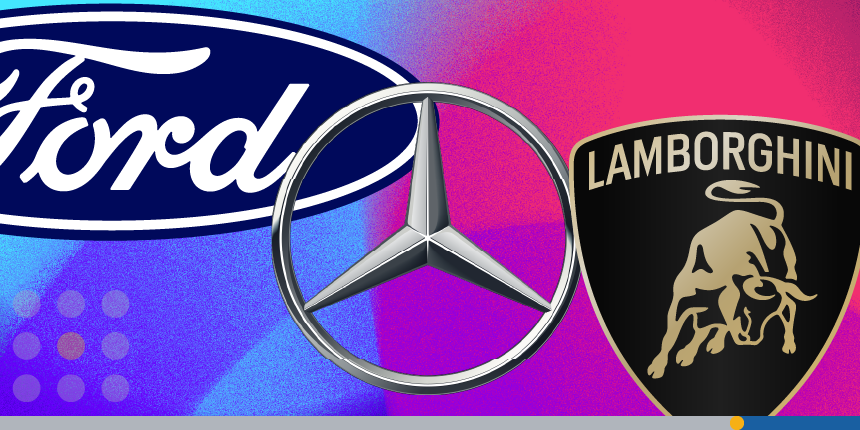
Legendary Automotive Logos
Car company logos are like little stories that show off a brand’s history and values! They often feature sleek and stylish designs that communicate things like luxury, reliability, and performance. A touch of simplicity and symmetry makes these logos easy to recognize and remember, even when you’re zooming by or seeing them from far away!
1. Ford
The classic Ford logo can be traced back to 1912. This writing appears to be influenced by Henry Ford’s own signature. In 1927, Ford started using the iconic oval badge shape that would become synonymous with the brand.
Over the years, Ford has made small edits to the logo, using slightly different shades of blue for the oval background, but the overall design has remained the same. The Ford blue oval symbolizes strength, heritage, and reliability.
While Ford has evolved its logo to appear more modern, the logo is really the perfect example of the “if it ain’t broke, don’t fix it” mentality.
2. Mercedes Benz
The Mercedes Benz has one of the most famous logos of all time and perhaps the most simple. The logo is just a three-pointed star, a symbol that anyone can easily draw on a piece of paper. In fact, that is exactly what Mercedes-Benz founder Gottlieb Daimler did. Daimler used the three-pointed star to mark his house on a postcard. The company’s logo is a tribute to Daimler and the Daimler family homeland.
There is some additional symbolism connected to the Mercedes-Benz logo. The star’s three points represent land, sea, and air — areas the company believed they would one day dominate with Mercedes-Benz engines. Since its creation in 1926, the Mercedes-Benz logo has come to symbolize the brand’s core values of innovation, luxury, and global reach.
3. BMW
BMW – the Bayerische Motoren Werke or Bavarian Motor Works – emerged from a renaming of the aircraft engine manufacturer Rapp Motorenwerke, located in Munich, the capital of the State of Bavaria in southern Germany. In 1917, the new firm received a company logo, which retained the round shape of the old Rapp logo but now included the letters BMW.
The company’s home state of Bavaria was also to be represented on the company logo. The quarters of the inner circle on the BMW badge display the state colors of the State of Bavaria – white and blue.
Due to the company’s history as an aircraft manufacturer, many people have interpreted the BMW logo to represent a spinning propeller. While not technically accurate, this interpretation remains popular among BMW fans.
4. Lamborgini
Ferruccio Lamborghini founded Lamborgini in 1953, but it was not until 1963 that the famous Lamborghini bull appeared for the first time on the company logo.
Many people believe that the Lamborghini Bull was featured in the company logo to represent the power of the cars being built. But the real reason for the bull’s inclusion was because Ferruccio Lamborghini was born a Taurus, and he felt the symbol represented him personally. Ferruccio was also a big fan of bullfighting, which is why the bull on the logo is in a “fighting” stance.
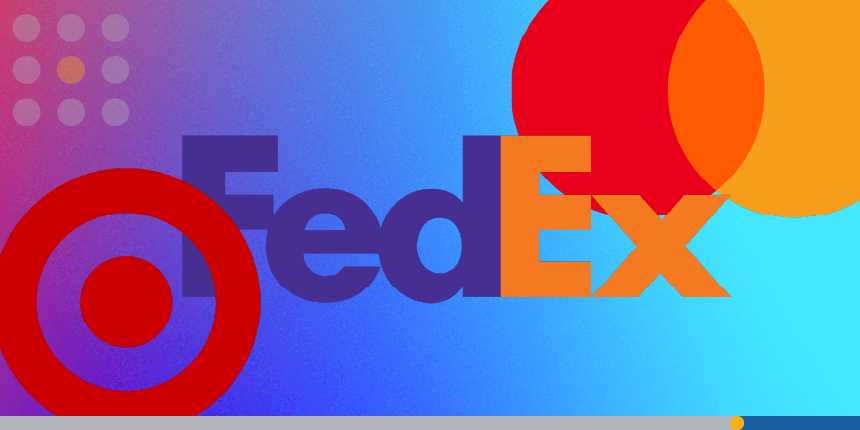
Convenience Brands with Amazing Logos
Convenience brand logos are created to be welcoming, helping customers understand that they can easily find what they need in no time. Trust and accessibility are two of the main elements that these logos are trying to put forth.
1. FedEx
FedEx delivers more than 15 million express and ground packages every day, a far cry from the 186 packages it delivered the first day of operations back in 1973.
The FedEx logo is celebrated for its hidden arrow formed by the negative space between the “E” and “X,” symbolizing speed, precision, and forward movement. The optical illusion using negative space gives the FedEx logo an added dimension without cluttering up the image. This subtle detail is considered a masterpiece of modern company logo design.
The company also uses unconventional brand colors that come together in a unique and effective strategy. “Fed” is in purple, while “ex” pops in orange. The combination of purple and orange is not commonly found in other famous logos.
FedEx has worked hard to incorporate those colors into its brand strategy. The FedEx Purple Promise is that its employees will do everything in their power to provide an outstanding experience for their customers.
Colors are such an important factor when designing a company logo. When you use FreeLogoServices to create a business logo, you have complete control over your color customization options.
2. Target
Target’s famous logo is straightforward yet powerful: a red bullseye. This design incorporates the brand’s name and conveys precision and reliability. Its simplicity makes it easily recognizable, even without text.
Launched in 1962, 200 names and symbols were discussed before the team decided to settle on Target as the name. At first, Target had a wordmark logo, but in 1968, the company decided to go with the red bullseye design.
In the years since, the Target logo has experienced minimal design changes and has only been subject to variations along the way.
3. Mastercard
Mastercard’s interlocking red and yellow circles represent connection and global acceptance. The overlapping section signifies shared values and integration, which aligns with the company’s mission to connect people through payment solutions.
The Mastercard logo has become synonymous with every financial transaction involving credit cards. Mastercard’s communication has always been about a balance between moments that money can and cannot buy. The brand found itself in the coveted sweet spot between both worlds, and this famous logo demonstrates it perfectly.
Both circles intersected for the first time in 1968. They have continued in this fashion, forming one of the most widely recognized financial logos the world has seen.
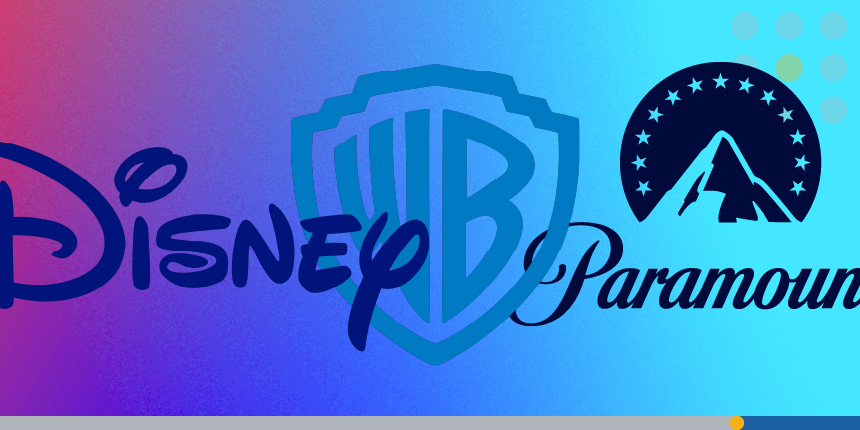
Great Logos From the Entertainment Industry
Some of the most famous logos ever created come from the entertainment industry. While brand building and marketing are important in all industries, the entertainment industry pays special attention to these things, which has resulted in some unbelievable logos.
1. Disney
Disney might be the most famous brand in the world today. Walt Disney Pictures develops movies that are seen by millions of people around the globe.
Disney initially took logo inspiration from its most famous character, Mickey Mouse. The first Disney logo looked more like a comic strip than a logo. The second company logo was a big departure from the first. Mickey was gone, and he was replaced with a much more simple logo that featured the name of the founder in a creative script font.
There were a few minor redesigns in the following years. In 1972, the word “Productions” was added in a simple sans-serif font, which would later be changed to “Pictures.” Walt Disney’s world-famous castle made its debut in the 1984 logo redesign. The castle was cut into several horizontal lines. A thin arch over the castle is left by the star that went across the screen in the older Disney intros.
In 2011, the words “Walt” and “Pictures” were completely removed from the logo, so the word “Disney” is the main focus. The Walt Disney logo reflects the brand’s focus on imagination and magic. The castle, in later versions, evokes dreams and the world of fairytales, aligning with Disney’s storytelling heritage.
2. Warner Bros.
Warner Bro. is one of the oldest movie studios in Hollywood. Over its extensive timeline, the renowned production company has undergone multiple transformations in its visual identity.
In 1929, the brand decided to simplify the company logo. The iconic “WB” inscription took center stage, becoming bolder and larger, effectively occupying all of the negative space. This new design would become the most famous lettermark logo ever created.
Warner Bros. would make significant changes to the company logo during the middle of the century, but in 1984, Warner Bros. brought back its classic, time-tested design. It showcased a badge with a ribbon against a blue sky with a golden abbreviation.
The story of the Warner Bros. logo shows how sometimes evolution means going backward. If you decide to redesign your company’s logo and it’s not working out, you can revert to an older version if it does a better job of presenting your company’s vision.
3. Paramount
Paramount’s current logo is made up of two prominent symbols. The first is a mountain, which was chosen to represent the childhood of founder W.W. Hodkinson. Hodkinson grew up in Utah and grew up alongside many mountains.
The second is the stars that surround the logo. The original meaning behind the stars was to include 24 stars that represented each “star” (or talent) that signed on with Paramount in 1914. To adapt the logo, two of these stars were dropped and the current logo only displays 22 stars.
The famous logo has appeared in many legendary films, including The Godfather, Titanic, and Saving Private Ryan.

Captivating Logos for Environmental & Relief Organizations
Logos for environmental and relief organizations are designed to inspire feelings of hope, compassion, and a strong bond with nature or humanity. You’ll often see cheerful images like trees, leaves, animals, or playful earth symbols in these logos, all representing our commitment to a sustainable planet.
1. World Wide Fund For Nature
The World Wide Fund For Nature (WWF) was initially known as the World Wildlife Fund. In 1985, the World Wildlife Fund international secretariat in Switzerland and a number of World Wildlife Fund affiliates changed their name from World Wildlife Fund to World Wide Fund for Nature.
For the past 60 years, the WWF has been addressing issues of climate change and sustainability with a single goal in mind: to help people and nature thrive. WWF’s panda is instantly recognizable as one of the most famous logos in the world.
The famous logo features Chi-Chi, a panda at the London Zoo in 1961. The WWF decided to go with a panda for their logo since the black-and-white design made printing costs way more manageable than a colorful mascot would have been. Plus, who can resist how beautiful pandas are? They’re cute, but they’re also endangered, making them a perfect symbol for the environmental issues we face today.
Incorporating Chi-Chi served both practical and symbolic purposes, and it worked out quite well, as the WWF Panda is a logo that almost anyone can identify.
2. National Geographic
The vertical rectangle of National Geographic is one of the most well-known and famous logos in the environmental space. The yellow color of the border is so well associated with the brand that National Geographic has rolled out several campaigns in the past where the logo appeared without the wordmark and still managed to be recognized by nearly everyone who saw it.
Some claim the logo is yellow to represent the sun and its reach, just like the magazines that spread across continents. Another belief states that the logo is rectangular to represent the shape of the National Geographic magazine itself.
This logo is proof that you can begin with a logo that is as generic as can be, but if it fits the context of your business, you have created a masterpiece.
The simple rectangle of the National Geographic logo represents a window to the world. The yellow color evokes curiosity and energy, fitting the brand’s focus on exploration and discovery.
3. Red Cross
While not a company logo, the Red Cross logo has become one of the most famous logos across the world. The Red Cross logo is derived from the Swiss flag with reversed colors, symbolizing neutrality and protection. The cross signifies aid and humanitarian efforts, aligning with the organization’s global mission to provide emergency assistance.
In 1864, the Geneva Conventions established the Red Cross emblem as the universal symbol of protection in armed conflict. Soon after, the Red Cross emblem was also adopted to identify the humanitarian services of the Red Cross national societies.
Since its inception, in situations of armed conflict, the Red Cross emblem says “don’t shoot”—this person, building, vehicle or equipment is not part of the fight but is providing impartial assistance.
Conclusion
Each of these famous logos tells a fascinating story that goes beyond the design; they’re like little symbols packed with the history, creativity, and meaning of the brands they represent.
A great logo can really help your business shine by making a connection with your customers and developing a stronger identity for your brand.
Hopefully, the stories behind these famous brands inspire you to come up with your own unforgettable logo!
Frequently Asked Questions
How important is color in logo design?
It really helps to call forth strong emotions and send specific messages. For example, when you think of blue, it often brings to mind trust and professionalism, like with brands such as IBM and Ford. Red is all about energy and passion—just look at Coca-Cola and Target. Color can really change how people see a brand.
Why do some logos change over time while others stay the same?
Logo redesigns are an awesome way to show how a brand is growing and changing. They can modernize their look or shift strategies to stay relevant. For example, companies like Google and Instagram update their logos to match new goals and ideas.
On the other hand, brands like Coca-Cola tend to keep their logos the same to highlight their rich traditions and stability. It’s interesting to see how different brands take different approaches.
What is the significance of simplicity in logos?
Simplicity ensures that logos are recognizable and versatile across various media. Simple logos, like those of Nike and Apple, are impactful, easy to remember, and adaptable for different uses, from digital screens to print advertising.
Why do some logos include the name of the company while others don’t?
The decision to include the company name often depends on brand recognition. Newer or less established brands might include their name to build awareness, while globally recognized brands like Apple or Nike can rely on their symbol alone to represent them.
What are some examples of hidden details in logos?
Several logos feature clever hidden details:
- FedEx has a hidden arrow between the “E” and “X” to signify speed and precision.
- Toblerone has a bear hidden in the mountain outline, representing Bern, Switzerland.
- Pepsi’s swirling design is said to be based on the golden ratio and other symbolic interpretations.
How do logos impact brand perception?
Logos create the first impression of a brand and contribute to brand perception. A great logo fosters brand loyalty by being recognizable and associated with positive experiences. Logos like those of McDonald’s and Disney evoke emotions tied to fun and nostalgia.
How long does it typically take to design a logo?
Designing a logo can take anywhere from a few days to several months, depending on the complexity of the project and the depth of research involved. Major brands often go through extensive brainstorming, revisions, and testing to create a logo that best represents their image.
How do brands ensure their logos stay relevant over decades?
Brands keep their logos relevant through subtle updates that retain the essence of the original while modernizing its look. This practice, known as “evolutionary rebranding,” helps companies like Pepsi and Ford stay contemporary without alienating their loyal customers.
